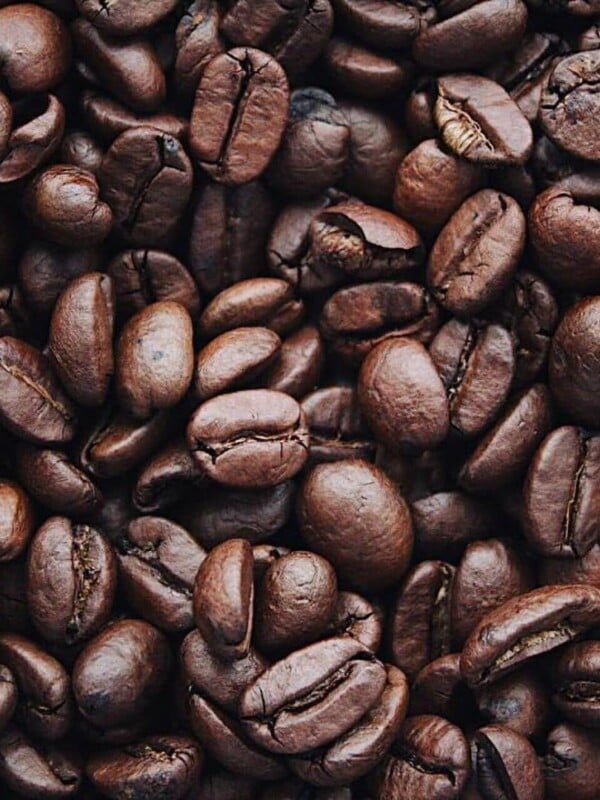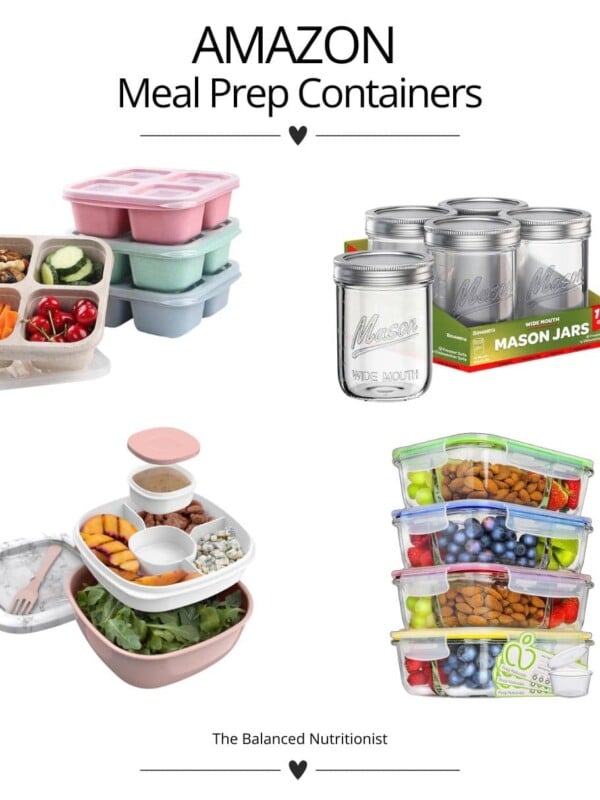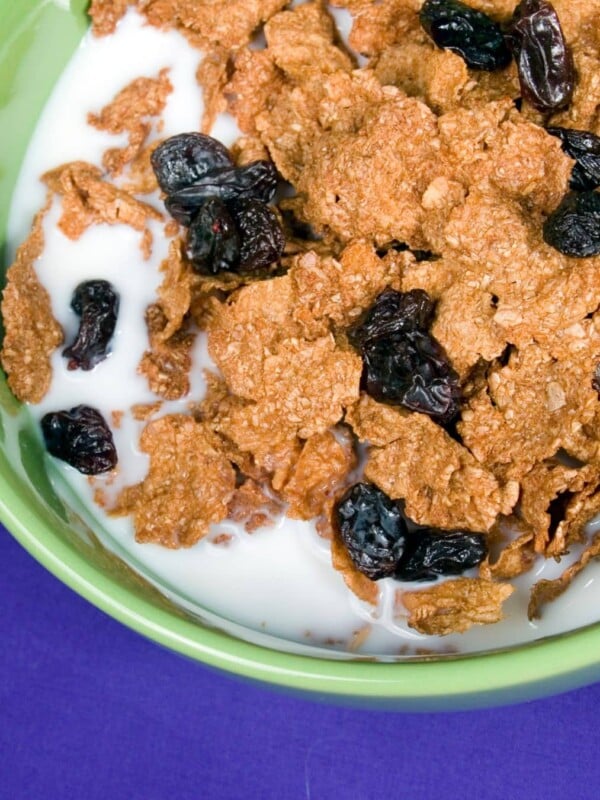This post may contain affiliate links. Please read our disclosure policy.
Making smoothies can be a great way to add lots of nutritious foods into your day, like fruits and vegetables. If you’re wondering what liquids work best in smoothies, I’ve got you covered. In this article, you’ll learn the best liquids for smoothies from a Registered Dietitian.
Psst if you love smoothies, you’ll gotta try my Detox Island Green Smoothie!

There are three main categories of liquids that work well in smoothies: water, juice, and milk. Let’s break them down and cover why you might choose one over the other.
Water
Plain water is always a great liquid option when you’re making a smoothie, especially if you have nothing else on hand. Many adults aren’t drinking enough water, so it’s an easy way to get more water in without thinking much about it.
Pros: It doesn’t add any sugar or calories to your smoothie, it’s hydrating, and it’s free from your sink!
Cons: It’s flavorless and can sometimes water down the flavor of a smoothie. Doesn’t work well with creamy smoothies that have ingredients like chocolate or peanut butter.
Tastes best in: Smoothies that have lots of fruit and natural sweetness, like this Sunrise Sunset Smoothie.
Milk and Milk Alternatives
Milk and non-dairy milk alternatives are also a great liquid option for smoothies, especially if you’re wanting a creamier smoothie. But, they can vary quite a bit nutritionally, so let’s go through them so that you can decide which is best for you!
Cow’s milk
Regular cow’s milk is high in protein, calcium, vitamin D, and B vitamins. Its nutrient content makes it a great choice for smoothies, especially if that smoothie doesn’t have another protein source, like Greek yogurt or protein powder. Curious about protein? I have a whole article on protein here!
You can choose whole milk, reduced-fat (2%) or skim milk, depending on your preference. Whole milk contains the most calories and fat per serving, and skim milk contains the least amount per serving. Personally, I love Fairlife milk because it’s higher protein.
Pros: Rich in protein, vitamins and minerals. Versatile and adds creaminess to smoothies.
Cons: May not taste as great in smoothies with lots of veggies.
Tastes best in: Fruit smoothies and smoothies that have other creamy ingredients like chocolate and peanut butter, like this Peanut Butter Cup Smoothie.

Almond milk
Almond milk is a great alternative to dairy for smoothies, but it’s typically less nutrient dense than regular milk and other plant-based milks. Look for almond milk that’s fortified with vitamin D and calcium to get as close to regular milk nutritionally as you can.
Almond milk typically comes in sweetened and unsweetened almond milk varieties, so you can choose based on your preference.
Pros: Dairy-free, lactose-free and a good source of vitamin E. Many unsweetened versions are readily available and are often lower calorie and lower carbohydrate than other plant-based milks.
Cons: Typically low in protein.
Tastes best in: Fruit smoothies, fruit and veggie smoothies, creamy smoothies.
Oat milk
Oat milk is another good option for dairy-free milk made from, you guessed it, oats! It naturally has a nice, creamy texture and slightly sweet flavor from the oats. But, many brands add sugar to their oat milk.
Another perk is that oat milk usually has 2-3 grams of fiber per serving. Oats contain soluble fiber which is beneficial for heart health.
Pros: Dairy-free, lactose-free and rich in B vitamins. Contains a couple of grams of soluble fiber per serving and is the creamiest of the dairy-free milks
Cons: Low in protein, higher in carbohydrates than other plant-based milk options and many brands contain added sugars.
Tastes best in: Fruit smoothies, a creamy smoothie like chocolate, banana, peanut butter, etc.
Coconut milk
Coconut milk is made from coconut flesh that’s pureed with water and then strained. The result is a super rich and creamy bright white liquid that can be used in anything from soups to curries to smoothies. Coconut milk is rich in nutrients like iron, folate, magnesium, selenium, and potassium.
There are two types of coconut milk: the one that you’ll find in a can that’s typically used for cooking, and the one that comes in a carton that’s used for drinking and in smoothies. For the purposes of smoothies, we’ll talk about the kind in the carton.
The kind in the carton that we’d use for smoothies tends to be a lot lower in calories and nutrients than the kind in a can. For example, 1 cup of Silk coconut milk has 40 calories, while 1 cup of canned coconut milk has 550 calories. That’s a big difference!
Pros: Dairy-free, lactose-free, rich in nutrients (although the carton kind is not as nutrient dense), flavorful, and low carbohydrate.
Cons: Strong coconut flavor if you don’t like coconut, low protein.
Tastes best in: Smoothies with tropical flavors like mango and pineapple. Goes great in this Bahama Mama Smoothie!
Soy milk
Soy milk is made from soy beans. Unlike many other plant-based milks, soy milk is a good source of protein, making it a great option. A major plus! Some soy milks have up to 9g of protein, like this soy milk from Pacific Foods.
Like most plant-based milks, there are unsweetened and sweetened varieties and many are fortified with vitamins and minerals. Soy milk also contains iron and potassium.
Soy milk also has some potential health benefits, too. Consuming soy milk may help to improve cholesterol, reduce blood pressure and even lower inflammation.
Pros: Dairy-free, lactose-free, high in protein and contains iron and potassium. Often fortified with vitamins and minerals. Potential health benefits.
Cons: Many varieties contain added sugar, so be on the lookout.
Tastes best in: Fruit smoothies, creamy smoothies like chocolate, peanut butter, banana, etc.
Pea milk
Like soy milk, pea-based milk is a great source of protein. Pea milk is made from yellow peas that get milled into flour and then blended with water and other ingredients. A cup of pea milk has 8 grams of protein, 80 calories and is often fortified with calcium, vitamin A and vitamin D.
Flavor-wise, it tends to get mixed reviews. You’ll have to try it yourself to see how you feel about it!
Pros: High in protein, creamy, rich in nutrients, typically less added sugar than other plant-based milks.
Cons: Not typically as palatable as other plant-based milks.
Tastes best in: Fruit smoothies, fruit and veggie smoothies, creamy smoothies like banana, chocolate, nut butter, etc.

Juice
Fruit juice
Fruit juice is an easy way to pump up the flavor of your smoothies, especially if you’re adding leafy greens. Unfortunately, fruit juice also tends to be pretty high in sugar. Fruit isn’t problematic just because it has sugar despite what diet culture might tell you, but there are things to keep in mind.
But, fruit juice isn’t quite the same as eating the whole fruit, because the fiber has been removed. When you remove the fiber, you’re just left with the vitamins and minerals in the juice along with its natural sugars. For example, 1 cup of apple juice has 24 grams of sugar.
On the plus side, juice is often a great source of vitamins and antioxidants, especially juices like cranberry juice, grape juice, and orange juice. But, if you’re trying to cut out extra sugar, juice on top of the fresh fruit in your smoothie might not be the best option.
If you choose to use juice, go for 100% juice and try different combinations like ½ juice and ½ water to be mindful of the sugar content. Personally, as a dietitian, I like to use low-sugar liquids and add whole fruit to smoothies for max nutrition!
Pros: Tasty, flavorful, often a good source of vitamins and antioxidants.
Cons: Potentially adds a significant amount of calories and sugar to your smoothie.
Tastes best in: Fruit smoothies, fruit and veggie smoothies
Coconut water
Coconut water is technically a juice and it’s found in the center of young, green coconuts. It’s naturally pretty low in calories as well as a source of electrolytes like potassium and magnesium. It does contain some natural sugars, but only about 8g per cup.
It also has some potential health benefits too like antioxidant properties and replenishing fluids and electrolytes after exercise.
Pros: Flavorful, hydrating and a natural source of some nutrients.
Cons: Strong coconut flavor (if you don’t like coconut)
Tastes best in: Fruit smoothies, green smoothies fruit and veggie smoothies (especially smoothies with tropical flavors like mango and pineapple).
So, which is the best choice?
The best liquid option for your smoothie is the one that you enjoy and makes sense for you nutritionally. Honestly, they can all be a good choice for a healthy smoothie, it just depends on your personal preference and what you need!
If you’re aiming for less sugar in your diet, you might want to pass on sweetened milks or juice. If you’re looking for a higher protein smoothie option, you’ll want to go for cow’s milk, soy milk or pea milk for a boost of protein.
The good news: each liquid base option has pros and cons, and none of them are wrong!
Ultimately what matters most is the total combination of your smoothie ingredients, not just the liquid. Try out different combinations to find the best liquid choice for you!













